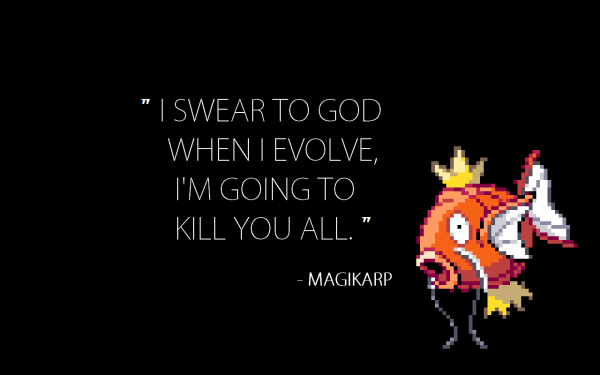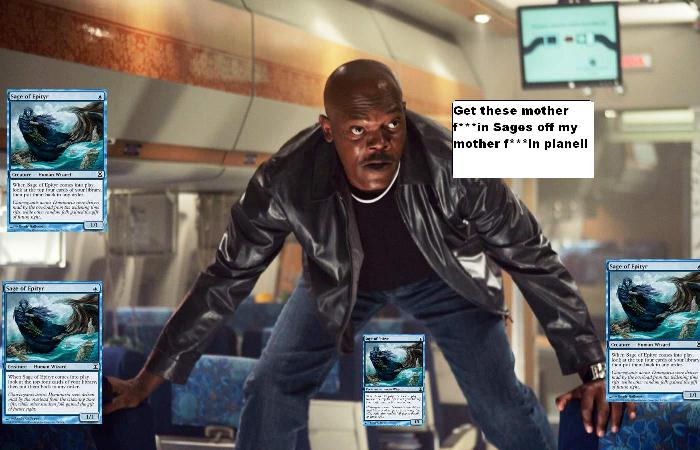The Guide To Vintage’s Landscape – Attacking The Red Zone
I mentioned in my last article that I was going to go over all of the non-Gush blue decks in the format. However, based on the feedback (which was exactly what I was looking for) I have received and at the risk of painting an undesirable picture of Vintage, I am going to save the rest of the blue decks for the end. Another big misconception is that Vintage is a format dominated by Islands, Tinkers, Time Vaults, and the restricted list cards…

I realized that I probably should have laid out all the chips on the table when talking about the bevy of decks one could play in Vintage in my first article. So this is what I am going to do, give everyone the unofficial road map to Vintage’s metagame. The overall picture of where the Vintage metagame stands right now is quite expansive, but as an appetizer to the rest of the series here is the breakdown of deck types I plan to cover. The list will obviously not include every single deck possible in Vintage, as I could write for months about that. What I want to include is a catalog of the modern Vintage metagame, and I feel this list encompasses most of it.
Noble Fish
Delver Gush
BUG Fish
Wizards!
Sage Fish
The Mountains Win Again
The Plateaus Win Again
Goblins
GW Hate Bears
Christmas Beatings
Sui Black
Food Chain Goblins
ELVES!
Dark Times
Two Card Monte
Painter
Belcher
Minus 6
Bomberman
Ritual Decks
Oath Decks
Dredge Decks
Workshop Decks
Blue Decks (non-Gush)
Even though there are 24 items listed the number of decks by the time this series is complete will almost double that. One of the key and often misunderstood concepts in Vintage is that on the surface all Ritual, Oath, Dredge, Workshop, Gush, and Blue decks look alike. To most non-Vintage players and new players, there is no hiding the fact that yes, a lot of the cards in these archetypes may or may not be the same. The key differences however are how they are deployed and utilized within a game, a concept I should have initially explained and went over.
I believe this is clearest and best exemplified when examining Gush. I want to take a look at the breakout Delver Gush deck from a recent tournament and a more traditional Gush control deck, both of which have top 8ed within the past few weeks.
Creatures (13)
Planeswalkers (2)
Lands (16)
Spells (29)

Creatures (1)
Planeswalkers (3)
Lands (15)
Spells (41)
- 1 Sensei's Divining Top
- 1 Brainstorm
- 1 Fastbond
- 3 Mana Drain
- 1 Vampiric Tutor
- 1 Yawgmoth's Will
- 4 Force of Will
- 1 Sol Ring
- 1 Demonic Tutor
- 1 Hurkyl's Recall
- 1 Time Walk
- 1 Ancestral Recall
- 1 Imperial Seal
- 1 Mana Crypt
- 4 Gush
- 1 Time Vault
- 1 Gifts Ungiven
- 1 Merchant Scroll
- 1 Tinker
- 1 Voltaic Key
- 1 Black Lotus
- 1 Mox Emerald
- 1 Mox Jet
- 1 Mox Pearl
- 1 Mox Ruby
- 1 Mox Sapphire
- 1 Ancient Grudge
- 1 Ponder
- 2 Preordain
- 3 Mental Misstep
Sideboard

Both of these decks have the Gush-Bond engine, and yes they admittedly both have the restricted list of blue spells and tutors. However, the end game, the tutor plans, and game plan are completely different for both decks.
East Coast Wins (ECW) plays a more controlling and prolonged game. Breaking it down, we can easily determine that ECW wants to focus on getting one of Vintage’s uber combos online, Tinker-Blightteel or Time Vault–Voltaic Key. That’s the deck’s primary end game, and one of the best ways for it to achieve that end game is to maximize its chances of drawing the pieces. ECW does by using its tutors to obtain combo pieces while using its counters to protect itself from their opponent’s game plan.
One of the toughest things for new Vintage players is getting maximum value from tutors and knowing when to deploy them correctly. This isn’t an article on that (not yet anyway… in the future), but I want to touch on it because it demonstrates what I mean by cards being utilized differently in different decks. In a deck like ECW where you have powerful two-card combos, counterspells, and Yawgmoth’s Will, you have a bunch of different options for your tutors.
The most basic line of play with them is to just get one of your game ending combos and try to win. There are a ton of different reasons why or why you would not go for this line of play, i.e. your opponent has a full grip and you don’t have a counterspell, or maybe your opponent has no hand in which case it’s correct to just go for it.
Another line of play is setting up a tutor chain into a big Yawgmoth’s Will. One of the advantages to this play is it gives you a lot of flexibility if your Yawgmoth’s Will resolves to basically win on the spot thanks to all of the tutors in your yard. Another advantage is that if your opponent only has one counterspell in hand, they are more likely to allow your tutors to resolve in order to counter what you actually tutored for (thinking it’s a business spell), but in this case you’re setting up a full tutor chain. One of the disadvantages is that this line of play could take over multiple turns and will almost require you to have a counterspell of your own in hand as well as the mana to maximize the value from your Yawgmoth’s Will.
Another approach with tutors in ECW is setting up a counterspell wall with your tutors and looking to run into your Yawgmoth’s Will or a combo itself and have sufficient protection to stop your opponent until you do, or win a counter war over the combo or Yawgmoth’s Will. Knowing what to tutor for and when to do it really leads to the complexity of game play that Vintage has, and while it might not appeal to everyone it’s one of the key junctures in a Vintage game where you are attempting to outplay your opponent.
The game plan is a little different with Delver Gush. There are no uber combos to get with your tutors, taking a ton of extra turns, no attacking with a Blightsteel Colossus; instead you are beating down with 1/1s, potential 3/2s, Tarmogoyfs, 2/1s, 2/3s, and a 3/1.
Your game plan is to win by….
…COMBAT DAMAGE!!!
The old fashion Dirty Harry way of getting into the red zone and tapping creatures whose power is four at best….

“Mark you have to be lying; only Blightteel does the swinging in Vintage!!!”
“That’s just absurd; I thought Vintage was all about doing broken combos and winning with uber spells like Tendrils of Agony, Tinker, Time Vaults, etc.”

The tutors in this deck are used in a different way than ECW or a deck with uber combos. Your lines of play with the tutors are to set up a counter wall to protect your creatures and/or stop your opponents’ game plan. You can use them to find more gas to put the pressure on your opponent, put a spell on top of your deck to flip your Delver of Secrets, find a way to deal with your opponent’s Blightsteel Colossus (Hurkyl’s Recall, Jace, etc.), and maybe even Time Walk to get an extra attack in maybe even for the win. Basically what I am pointing out is that despite the similarity of cards in both decks they are used in VASTLY DIFFERENT ways.
Bringing the Pain in Vintage – When Fishes Attack
Just not this one…

For this part of the series, instead of the traditional blue decks, I am going to go over bringing the pain and getting into that Red Zone… aka attacking with things other than Zombies and 11/11 infect creatures.
Fish, this is generally the term used to describe creature decks in Vintage. The name ‘Fish’ was jargon for Merfolk and has since evolved to describe blue-based aggro-control decks. Now granted, I am using it pretty loosely here, as Goblins isn’t actually a “fish” deck, but the goal here is to present all the options in Vintage if you like turning guys sideways and getting into the red zone. I felt it more imperative to show just how unique and different the playable card pool is in Vintage compared to my last article to really display just how many options you have when it comes to selecting a deck. All of the decks I go over in this article will have the same basic game plan, mana denial and turning creatures sideways. We already touched on one of the newest creations to fish with Delver Gush, but I want to start with one of the most arguably popular fish decks in the format currently… Noble Fish.
Noble Fish
Creatures (17)
- 1 Trygon Predator
- 4 Noble Hierarch
- 4 Qasali Pridemage
- 1 Stoneforge Mystic
- 1 Thada Adel, Acquisitor
- 2 Phyrexian Revoker
- 1 Edric, Spymaster of Trest
- 2 Scavenging Ooze
- 1 Snapcaster Mage
Lands (15)
Spells (28)

Creatures (18)
Lands (17)
Spells (25)

Creatures (20)
Lands (18)
Spells (22)
- 4 Force of Will
- 1 Time Walk
- 1 Ancestral Recall
- 4 Daze
- 1 Black Lotus
- 1 Mox Emerald
- 1 Mox Pearl
- 1 Mox Sapphire
- 4 Gitaxian Probe
- 4 Stony Silence
Sideboard

There are a lot of different configurations for Noble Fish, but the premise remains the same: keep churning out beaters while disrupting your opponent’s development and/or game plan. Mike Noble’s is the most streamlined, opting for a more threat and permanent dense build compared to the other two, which each provide a different toolbox of options. Qasali Pridemage is probably one of the biggest reasons this archetype exists in my eyes; its ability gives you such an advantage in Vintage at the moment.
List Time!!!
Things that Qasali Pridemage can destroy:
Fast Artifact Mana
Fastbond
Time Vault
Voltaic Key
Oath of Druids
Standstill
Crucible of Worlds
Mystic Remora
Sensei’s Divining Top
Mishra’s Factory
Technically and Literally Bridge from Below…
Pretty much any card in a Mishra’s Workshop deck
Etc…
The point is that every deck in Vintage has something that a Qasali Pridemage can take out. Being able to hit fast artifact mana with Qasali Pridemage fits in with one of the deck’s game plans, mana denial. Packing Wastelands, Strip Mine, and Stony Silence Noble Fish attacks mana development pretty efficiently. Paired with the deck’s aggressive and disruptive creature base as well as cheap counters, Noble Fish has the right mix of cards to be a winner in this metagame. Matt Elias covers Noble Fish, albeit dated some, in great detail here as well as some of the other fish decks we are going to go over. Next I want to go over the only fish deck to top 8 Vintage Champs this year…
BUG Fish
Creatures (11)
Planeswalkers (2)
Lands (19)
Spells (28)

As you will soon realize, most of the decks I will be going over in this article at their core operate because of a mana denial package while looking to capitalize on the tempo from it. All the decks we will talk about in this article will have Wastelands, Strip Mine, and Null Rod/Stony Silence in some capacity with the decks playing Islands using Daze as well. BUG Fish looks to utilize discard and tutor effects, two of black’s more powerful strategies in Vintage, while using Dark Confidant to fuel the deck.
Like I mentioned earlier, the tutors in this deck are more for the utility they bring rather than getting broken combos, which is the stereotype. It’s similar to Noble Fish in that the deck runs mana denial, but instead of relying on its creatures to do the heavy lifting it runs a heavier mix of spells to disrupt its opponent. You have better flexibility in both terms of game play and build configurations thanks to the tutor package you are playing, as well as access to stronger Dredge hate. The one of Life from the Loam can end a lot of games quickly as well when paired with a Strip Mine. At the end of the day this is the type of Fish build I would most likely play thanks to number of options you have thanks to the tutors and Jace, the Mind Sculptor. Next I want to look at a deck that surprising packs quite the punch as well as results… Wizards!
WHAT!?!?!?!?
Wizards!
Now we are going to enter the twilight zone of the article where the lines of reality and fiction start to blur. Cards that you thought didn’t even exist let alone be playable in Vintage begin to make top 8s and in some cases even win tournaments.
Warning: Cards Discussed Beyond This Point May Alter Your Perception of Vintage or Just Cause Your Head to Explode…

Creatures (23)
- 4 Voidmage Prodigy
- 3 Meddling Mage
- 2 Stormscape Apprentice
- 4 Dark Confidant
- 3 Cursecatcher
- 3 Phyrexian Revoker
- 4 Leonin Relic-Warder
Lands (17)
Spells (20)

Creatures (20)
Lands (17)
Spells (24)
- 4 Force of Will
- 3 Swords to Plowshares
- 4 Aether Vial
- 1 Time Walk
- 1 Ancestral Recall
- 1 Black Lotus
- 1 Mox Pearl
- 1 Mox Sapphire
- 4 Chalice of the Void
- 4 Engineered Explosives
Sideboard

Your eyes do not deceive you; you are literally looking at a WINNING and a top 8 list from two separate tournaments. You may even have to click on some of the cards so you know what they actually do… I’ll wait…
Anyway I think one of the main problems Vintage has is that too many of its established players get locked into one archetype. I also think a lot of times people are too afraid to experiment and/or just overwhelmed by Vintage’s card pool. We are now heading down a path where Vintage is pretty wide open, and a lot of the decks I will be posting are from actual top 8s and not 8-15 man tournaments either. It just goes to serve as a reminder: don’t be afraid to play cards off the beaten path. It’s Vintage; play something because you think it’s fun, enjoyable, cool, whatever….
Again, we have our core mana denial component with Wastelands and Strip Mine, but these decks look to utilize Aether Vial as well, thus ruling out the use of Null Rod/Stony Silence. Because of this, both decks have Chalice of the Void, which they can use on zero providing a similar effect that Null Rod/Stony Silence provides, which is stopping your opponents’ fast artifact mana. Voidmage Prodigy turns all of your creatures into literal Counterspells on a stick, providing great tempo and beats to help you stay ahead of your opponent. It also gives you a great way to get rid of your own Dark Confidant if you’re close to being killed by it. It is also interesting to note that Nat chose to go only three colors for a more stable mana base compared Omar who went four colors to maximize his Engineered Explosives capability (Bye bye, Jace…) while giving him access to one of the best two-drop creatures I believe Fish archetypes can run, Qasali Pridemage. Now we are going to really try to blow your mind….
Sage Fish!?!?!?!
Creatures (15)
Planeswalkers (2)
Lands (20)
Spells (23)

Creatures (19)
- 4 Ninja of the Deep Hours
- 2 Devout Witness
- 4 Meddling Mage
- 1 Jotun Grunt
- 4 Sage of Epityr
- 4 Phantasmal Image
Lands (18)
Spells (23)
- 4 Force of Will
- 4 Swords to Plowshares
- 1 Time Walk
- 1 Ancestral Recall
- 3 Null Rod
- 3 Daze
- 2 Stifle
- 1 Black Lotus
- 1 Mox Pearl
- 1 Mox Sapphire
- 2 Spell Pierce
Sideboard

ARE YOU KIDDING ME? SAGE OF EPITYR?!?!?

Anyway, Sage of Epityr is a one-mana wannabe Ponder on a stick. Paired with Ninja of Deep Hours, you get to reuse him as well as the deck’s other come into play effect creatures if need be. Ninja is also great in that if they don’t have a blocker, he can be a good draw engine to help provide more fuel. Nat’s list is a little more involved thanks to running cards like Jace, the Mind Sculptor and Back to Basics, which can be a total blowout against Mishra’s Workshop and Bazaar of Baghdad as well as dual land. Waterfront Bouncer gives you another way to reuse your Snapcaster Mages and deal with opposing Blightteel Colossi.
Moving on… We are going to now look at decks that run… gasp… NO ISLANDS…
TMWA/TPWA
I decided to group both TMWA (The Mountains Win Again) and TPWA (The Plateaus Win Again) in my analysis. Both decks run a very similar set of cards with a very similar game plan except that TPWA opts for some additional help from white.
Creatures (27)
- 3 Goblin Vandal
- 2 Gorilla Shaman
- 4 Kataki, War's Wage
- 4 Simian Spirit Guide
- 4 Magus of the Moon
- 4 Leonin Arbiter
- 3 Phyrexian Revoker
- 3 Hero of Oxid Ridge
Lands (17)
Spells (16)

Creatures (22)
- 3 Goblin Welder
- 2 Gorilla Shaman
- 4 Kataki, War's Wage
- 4 Simian Spirit Guide
- 4 Magus of the Moon
- 2 Leonin Arbiter
- 1 Accorder Paladin
- 2 Hero of Oxid Ridge
Lands (16)
Spells (22)
- 4 Lightning Bolt
- 1 Mana Vault
- 1 Sol Ring
- 2 Fireblast
- 4 Red Elemental Blast
- 1 Mana Crypt
- 1 Gamble
- 4 Artifact Blast
- 1 Black Lotus
- 1 Mox Pearl
- 1 Mox Ruby
- 1 Path to Exile
Sideboard

Creatures (19)
- 2 Goblin Welder
- 2 Gorilla Shaman
- 4 Simian Spirit Guide
- 4 Magus of the Moon
- 4 Figure of Destiny
- 3 Manic Vandal
Lands (17)
Spells (24)
- 4 Lightning Bolt
- 3 Red Elemental Blast
- 4 Null Rod
- 2 Blood Moon
- 3 Pyrostatic Pillar
- 1 Black Lotus
- 1 Mox Ruby
- 4
- 2 Smash to Smithereens
Sideboard

Here we have another component of mana denial in the form of Magus of the Moon. Magus is very well positioned right now. It shuts down fetchlands, dual lands, Mishra’s Workshop, Mishra’s Factory, and Bazaar of Baghdad to name a few. It is a great addition to the normal mana denial packages which include Null Rod/ Stony Silence, Wasteland, and Strip Mine. Even though your Wasteland and Strip Mine are shut down, some decks won’t be able to get out of the hole Magus of the Moon can put them in. You then have some other options when it comes to constructing your build of TMWA/TPWA. You can choose a more burn and/or artifact destruction approach or look to get maximum value and utility from your creatures.
TMWA/TPWA has access to some of the best anti-blue and anti-shop cards in the format: Red Elemental Blast/ Pyroblast, Magus of the Moon, Vexing Shusher, Gorilla Shaman (aka Mox Monkey Destroyer), Goblin Welder, Kataki, etc. Depending what you perceive the metagame to be at a given tournament there are many different ways to configure the deck and have it put in a position to perform extremely well. When you mention Mountains, you can’t leave out Goblins…
Goblins
Creatures (38)
- 2 Mogg Fanatic
- 4 Goblin Matron
- 4 Goblin Lackey
- 1 Kiki-Jiki, Mirror Breaker
- 4 Goblin Warchief
- 1 Goblin Sharpshooter
- 3 Goblin Piledriver
- 2 Gempalm Incinerator
- 1 Goblin Welder
- 2 Goblin Ringleader
- 2 Skirk Prospector
- 4 Simian Spirit Guide
- 3 Stingscourger
- 1 Lightning Crafter
- 4 Warren Instigator
Lands (17)
- 1 Strip Mine
- 4 Wasteland
- 12 Mountain
Spells (5)

What you will notice about Goblins and the TMWA/TPWA lists is that they both have Simian Spirit Guide, which for the most part is used as your one-shot ramp, essentially Lotus Petals 2-5. The Goblins list I am going over in this article is a pretty close port from Legacy, despite Goblin Recruiter being legal. In my next article I will go over combos which will include Food Chain Goblins, which does have Goblin Recruiter. Like all aggro strategies in Vintage you will once again see Null Rod, Wasteland, and Strip Mine as part of the mana denial plan. What’s interesting about this build is you have access to the Lightning Crafter combo:
Kiki-Jiki, Mirror Breaker + Lightning Crafter + Sharpshooter
- Play Kiki-Jiki
- Play Crafter
- Put the champion trigger on stack
- Copy Crafter with Kiki-Jiki.
- Let Kiki-Jiki be championed by the copy
- Deal 1 to the opponent with Sharpshooter
- Tap the copy of Crafter to kill itself
- Untap Sharpshooter
- Kiki comes into play untapped
- Repeat copying of Crafter
GW Hatebears
GW Haterader is another long, tried, and true archetype that has a long history of appearing in metagames throughout multiple formats. Naturally it made its way to Vintage, forgoing blue, it has adapted much of Noble Fish but has some key cards in place of the blue versions counterparts.
Creatures (25)
- 4 Elvish Spirit Guide
- 3 Kataki, War's Wage
- 4 Aven Mindcensor
- 4 Tarmogoyf
- 3 Gaddock Teeg
- 4 Noble Hierarch
- 3 Leonin Arbiter
Lands (19)
Spells (16)
- 4 Swords to Plowshares
- 3 Null Rod
- 1 Black Lotus
- 1 Mox Emerald
- 1 Mox Pearl
- 2 Nature's Claim
- 4 Mental Misstep
Sideboard

Mana Denial… If you make any type of Fish and/or Aggro deck make sure you have some slots for mana denial. You have Elvish Spirit Guide in this build for some of your mana ramp, plus an extra beater late game. The key cards in this build are the additions of Kataki, Aven Mindcensor, and Gaddock Teeg. Noble Fish can certainly just jam in Aven Mindcensor and Kataki, but Gaddock Teeg is key if you decide to forgo blue. Since you aren’t playing Force of Will yourself, Gaddock Teeg won’t turn any of your draws dead. Gaddock Teeg shuts down a lot of key cards in the format right now: Lodestone Golem, Force of Will, Gush, Jace, the Mind Sculptor, Dread Return, and Tendrils of Agony just to name a few… Leonin Arbiter and Aven Mindcensor really make it a pain for decks that use tutors to find their uber combos, plus you have good ole Tarmogoyf beats…
There is one more aggro strategy I want to talk about in Vintage; it’s only fitting given the time of the year it is… Christmas Beatings aka RG Beats….
HO HO HO, Christmas Beatings!!
Creatures (25)
- 4 Elvish Spirit Guide
- 3 Tin Street Hooligan
- 4 Simian Spirit Guide
- 3 Stingscourger
- 4 Magus of the Moon
- 4 Tarmogoyf
- 3 Phyrexian Metamorph
Lands (17)
Spells (18)

A lot of this deck is made up of much of what we already covered so I will be a bit brief on this one. The interesting card of note is the Phyrexian Metamorph, which essentially lets you copy your best creatures to keep the pressure on, or one of your opponent’s even. You also are given the extra utility to copy artifacts, which could be useful if someone has a Crucible of Worlds and is trying to Strip Mine you out…
John Jones was able to win a very recent tournament with this list against quite the impressive field, which included Vintage Juggernaut Paul Mastriano in the finals and Vintage Champs top 8 competitor Joe Brown. I believe it’s a strong testament that Vintage is not only wide open right now but that aggro strategies can be competitive.
2012 Northeast Vintage Series
Something great in the making is happening in the Northeast United States this coming year for Vintage. Tournament organizers Nick Detwiler and Nick Coss have created something not seen in Vintage since SCG ran their own Power 9 series. It’s too good for me to even try to explain here but if you live in the NE United States and you play Vintage it is something you should definitely attempt to attend.
Here is the announcement of the greatest thing to happen to Vintage since SCG’s Power 9 Series… http://www.themanadrain.com/index.php?topic=43560.0
I want to give a special shout out and congrats to Paul Mastriano for probably one of the best years had by a Vintage player. This guy was not only my Vintage Champs end boss, but won the NYSE Vintage Player of the Year award as well as finishing runner-up to Josh Potucek for Blue Bell Vintage Player of the Year; congrats to Josh Potucek as well. Next article I plan to go over Vintage’s more unique combo decks and we aren’t talking about Tinker/Blightteel, Vault/Key, and Oath…
@womba_ on Twitter
